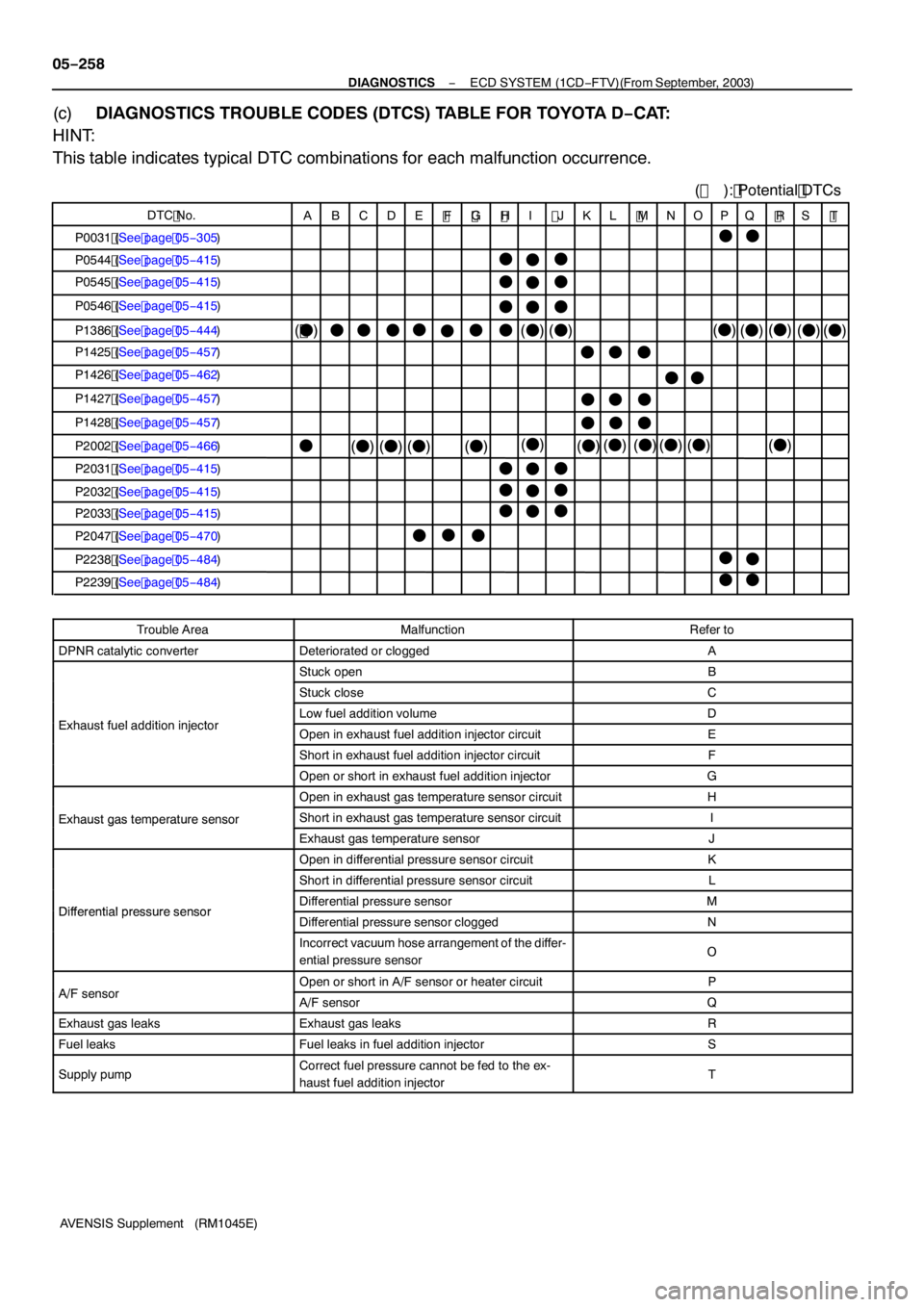TOYOTA AVENSIS 2005 Service Repair Manual
Manufacturer: TOYOTA, Model Year: 2005, Model line: AVENSIS, Model: TOYOTA AVENSIS 2005Pages: 5135, PDF Size: 95.28 MB
Page 4331 of 5135

−
DIAGNOSTICS ECD SYSTEM (1CD −FTV)(From September, 2003)
05 −267
AVENSIS Supplement (RM 1045E)
9 SYMPTOM SIMULATION (See page 05 −282)
1 0 DTC CHECK (See page 05 −290)
AMalfunction code
BNo code
B GO TO STEP 12
A
11 PROCEED TO DTC CHART (See page 05 −299)
GO TO STEP 14
12 BASIC INSPECTION (See page 05 −27 1)
ANot confirm wrong parts
BConfirm wrong parts
B GO TO STEP 17
A
1 3 PROCEED TO PROBLEM SYMPTOMS TABLE (See page 05 −282)
AConfirm wrong circuit
BConfirm wrong Parts
B GO TO STEP 17
A
1 4 CHECK ECM POWER SOURCE CIRCUIT (See page 05 −489)
1 5 CIRCUIT INSPECTION
ANot confirm malfunction
BConfirm malfunction
B GO TO STEP 18
A
Page 4332 of 5135

05−268
−
DIAGNOSTICS ECD SYSTEM (1CD −FTV)(From September, 2003)
AVENSIS Supplement (RM 1045E)
16 CHECK FOR INTERMITTENT PROBLEMS (See page 05 −270)
GO TO STEP 18
17 PARTS INSPECTION
1 8 PROBLEM IDENTIFICATION
1 9 ADJUSTMENT AND/OR REPAIR
20 CONFIRMATION TEST
END
Page 4333 of 5135

05I7Z−01
A91210
Engine Control System Diagram:
Accelerator Pedal
Position Sensor
Ignition Switch Signal
Starter Signal
Vehicle Speed Signal
DLC3Supply Pump
Pressure Discharge Valve Fuel Pressure Sensor
EDU Relay
EDU
Atmospheric
Temperature
Sensor
Glow
Plug Relay
Crankshaft Position SensorCamshaft
Position
SensorCommon Rail Suction Control Valve
Alternator Duty SignalDCAT Switch
ECM
Atmospheric
Pressure
Sensor
A/F Sensor Heater
Mass Air Flow Meter
Differential
Pressure Sensor
A/F Sensor Actuator
E−VRV
Exhaust Gas Temperature Sensor
(Up Stream)
Exhaust Gas Temperature Sensor
(Down Stream)Glow Plug EGR Valve
Injector
Turbo Pressure
Sensor
Engine Coolant
Temperature Sensor
Intake Air
Temperature
Sensor
Fuel Temperature Sensor
EGR Cooler Inter Cooler
Exhaust Fuel
Addition
Injector
DPNR Catalytic Converter
Turbocharger
(INJT and PRD Signal)
(INJF Signal)
Intake Shutter
(Throttle Valve)
Oxidation Catalytic
Converter
− DIAGNOSTICSECD SYSTEM (1CD−FTV)(From September, 2003)
05−255
AVENSIS Supplement (RM1045E)
SYSTEM DESCRIPTION
1. ENGINE CONTROL SYSTEM
Page 4334 of 5135

A85344
TOYOTA D−CAT Diagram:
DCAT
Switch
EDU
ECM
Common RailInjector
Fuel Tank EGR Valve
FReduces NOx (Linear Solenoid Type)EGR Cooler
FCools Down EGR GasExhaust Fuel Addition
Injector
FReduces NOxEGR Cooler Catalyst
FMaintains proper operation of EGR cooler
Differential Pressure
Sensor
Exhaust Gas
Temperature Sensor
FMonitors catalyst
A/F Sensor
Oxidation Catalytic Converter
FReduces HC and CO Manifold Converter Sub−assy
(DPNR Catalytic Converter)
FReduces NOx, PM, HC, and CO Intake Shutter (Throttle Valve)
Supply Pump
FSupplies fuel to exhaust fuel addition injector
temperature FDPNR catalyst regeneration
FSupplies high pressure fuel to main injector via common rail
Pressure Discharge Valve
Fuel Pressure sensor
05−256
− DIAGNOSTICSECD SYSTEM (1CD−FTV)(From September, 2003)
AVENSIS Supplement (RM1045E)
2. TOYOTA D−CAT DESCRIPTION
(a)TOYOTA D−CAT:
Diesel Clean Advanced Technology (TOYOTA D−CAT) comprehensively regulates engine control (consists
of a catalytic system and a fuel injection system) that purifies both particulate matter (PM) and nitrogen ox-
ides (NOx) discharged by diesel engines.
The catalytic system purifies hydrocarbons (HC) and carbon monoxides (CO), and reduces PM and NOx
with a catalytic converter with the Diesel Particulate−NOx Reduction system (DPNR). The fuel injection sys-
tem adds fuel into the exhaust port using the exhaust fuel addition injector to produce RICH state for NOx
reduction and maintain a proper catalyst temperature for DPNR catalyst regeneration.
Page 4335 of 5135

− DIAGNOSTICSECD SYSTEM (1CD−FTV)(From September, 2003)
05−257
AVENSIS Supplement (RM1045E)
(b)TOYOTA D−CAT COMPONENTS:
ComponentDescription
DPNR catalytic converterReduces HC, CO, PM, and NOx.
Exhaust fuel addition in-
jectorAdds fuel into the exhaust port in order to produce RICH air−fuel ratio for NOx reduction. Also, raises catalyst temper-
ature for DPNR catalyst regeneration.
Exhaust gas temperature
sensorUsed for estimating DPNR catalytic converter temperature and adjusting fuel addition by ECM while DPNR catalyst
regeneration is performed. Also, detects DPNR catalytic converter temperature to prevent the catalytic converter
temperature from rising too high.
Differential pressure sen-
sorDetects the volume of PM deposits in and incorrect vacuum hose arrangement on the DPNR catalytic converter.
A/F sensorUsed for controlling air−fuel ratio. By controlling the air−fuel ratio, combustion control for low temperature combustion
and DPNR catalyst regeneration are properly regulated.
Page 4336 of 5135

DTC No.
( ): Potential DTCs
( F )
ABCDE F G HI JKL MNOPQ RS T
P003 1 (See page 05 −305)
P0544 (See page 05 −415)
P0545 (See page 05 −415)
P0546 (See page 05 −415)
P 1386 (See page 05 −444)
P 1425 (See page 05 −457)
P 1426 (See page 05 −462)
P 1427 (See page 05 −457)
P 1428 (See page 05 −457)
P2002 (See page 05 −466)
P203 1 (See page 05 −415)
P2032 (See page 05 −415)
P2033 (See page 05 −415)
P2047 (See page 05 −470)
P2238 (See page 05 −484)
P2239 (See page 05 −484)
F
F
F F
F
F FF
FF F F FFF
FF
F
F
F
F FF
F
F
F
F F F
F
F
F
FFF
F (
F )(F)
( F )
(F )(F )(F ) (
F )(F )
( F )
F
F
F F
F
F
(F )(
F )
( F )
( F )(
F )
F F F
F
( F )
( F )(F)( F)
05
−258
−
DIAGNOSTICS ECD SYSTEM (1CD −FTV)(From September, 2003)
AVENSIS Supplement (RM 1045E)
(c) DIAGNOSTICS TROUBLE CODES (DTCS) TABLE FOR TOYOTA D −CAT:
HINT:
This table indicates typical DTC combinations for each malfunction occurrence.
Trouble AreaMalfunctionRefer to
DPNR catalytic converterDeteriorated or cloggedA
Stuck openB
Stuck closeC
Eha stfeladditioi jectoLow fuel addition volumeDExhaust fuel addition injectorOpen in exhaust fuel addition injector circuitE
Short in exhaust fuel addition injector circuitF
Open or short in exhaust fuel addition injectorG
Open in exhaust gas temperature sensor circuitH
Exhaust gas temperature sensorShort in exhaust gas temperature sensor circuitIExhaustgastemperaturesensor
Exhaust gas temperature sensorJ
Open in differential pressure sensor circuitK
Short in differential pressure sensor circuitL
DifferentialpressuresensorDifferential pressure sensorMDifferential pressure sensorDifferential pressure sensor cloggedN
Incorrect vacuum hose arrangement of the differ-
ential pressure sensorO
A/Fse soOpen or short in A/F sensor or heater circuitPA/F sensorA/F sensorQ
Exhaust gas leaksExhaust gas leaksR
Fuel leaksFuel leaks in fuel addition injectorS
Supply pumpCorrect fuel pressure cannot be fed to the ex-
haust fuel addition injectorT
Page 4337 of 5135

− DIAGNOSTICSECD SYSTEM (1CD−FTV)(From September, 2003)
05−259
AVENSIS Supplement (RM1045E)
(d)DIAGNOSTICS TROUBLE CODE DESCRIPTION FOR TOYOTA D−CAT:
DTC No.Description
P0031Open or short in A/F sensor or heater circuit (Low output)
P0544Open or short in exhaust gas temperature sensor circuit (Up stream)
P0545Open or short in exhaust gas temperature sensor circuit (Up stream) (Low output)
P0546Open or short in exhaust gas temperature sensor circuit (Up stream) (High output)
P1386TOYOTA D−CAT fuel addition system malfunction
P1425Open or short in differential pressure sensor circuit
P1426Differential pressure sensor is clogged or has incorrect vacuum hose arrangement
P1427Open or short in differential pressure sensor circuit (Low output)
P1428Open or short in differential pressure sensor circuit (High output)
P2002DPNR Catalytic converter malfunction
P2031Open or short in exhaust gas temperature sensor circuit (Down stream)
P2032Open or short in exhaust gas temperature sensor circuit (Down stream) (Low output)
P2033Open or short in exhaust gas temperature sensor circuit (Down stream) (High output)
P2047Open in exhaust fuel addition injector circuit
P2238Open or short in A/F sensor or heater circuit (Low output)
P2239Open or short in A/F sensor or heater circuit (High output)
Page 4338 of 5135

A91221
Common Rail System Diagram (1CD−FTV Fuel System):
Sensors ECM EDU
Common Rail
Fuel Pressure SensorPressure Discharge
Valve
Supply Pump Assy
Suction Control Valve
Fuel TankMain
Injector
Fuel Filter
: High−pressurized Area
Exhaust Fuel
Addition Injector
Exhaust Port
To DPNR
Catalytic
Converter 05−260
− DIAGNOSTICSECD SYSTEM (1CD−FTV)(From September, 2003)
AVENSIS Supplement (RM1045E)
3. COMMON RAIL SYSTEM DESCRIPTION
(a)COMMON RAIL SYSTEM:
The common rail system stores high−pressurized fuel supplied from the supply pump in the common rail and
injects it using the injectors. Fuel injection timing and fuel injection volume are regulated by the ECM; it pro-
vides an electric current to the solenoid valve of the injector with the EDU to regulate them.
By storing high−pressurized fuel produced in the supply pump in the common rail, this system can always
offer stable fuel injection pressure regardless of the engine speed and engine load, even if a driving speed
is low. In addition, this system uses the injector that opens and closes its fuel passage with the Two−Wa y
Valve (TWV) therefore both the fuel injection time and volume are precisely regulated by the ECM.
The ECM monitors internal fuel pressure of the common rail with the fuel pressure sensor and commands
the supply pump to supply fuel to obtain a target internal pressure, approximately 30 to180 MPa (306 to
1,835 kgf/cm
2, 4,351to 26,106 psi). The ECM opens and closes the pressure discharge valve to improve
controllability for the common rail internal fuel pressure.
This system has two split fuel injections. It performs ”pilot−injection” as subsidiary fuel injection prior to the
main fuel injection to make combustion soft, and this helps to reduce engine vibration and noise.
Page 4339 of 5135

P0087 (See page 05−314)
P0088 (See page 05 −32 1)
P0093 (See page 05 −328)
P0 190 (See page 05 −314)
P0 192 (See page 05 −314)
P0 193 (See page 05 −314)
P0200 (See page 05 −368)
P0627 (See page 05 −429)
P 1229 (See page 05 −32 1)
P 127 1 (See page 05 −435)
P 1272 (See page 05 −435)
P
1238 (See page 05 −43 1)
DTC No. A
BC DEF
GH IJKL
(
F )
F
( F )
F F
FF F
F
F
F
F F
(
F )
( F ) F
(
F )( F)( F)
F F
F F (
F )
( F )
( F )
(
F ) F
P0
191 (See page 05 −367)
F ( ): Potential DTCs
(F )
−
DIAGNOSTICS ECD SYSTEM (1CD −FTV)(From September, 2003)
05 −26 1
AVENSIS Supplement (RM 1045E)
(b) COMMON RAIL SYSTEM COMPONENTS:
ComponentDescription
Common railStores high −pressurized fuel produced by the supply pump
Supply pumpOperated by the crankshaft, and supplies high −pressure fuel to the common rail
InjectorInjects fuel to the combustion chamber based on signals from the ECM
Fuel pressure sensorMonitors internal fuel pressure of the common rail and sends signals to the ECM
Pressure discharge valveBased on signals from the ECM, opens the valve when sudden deceleration is occurred, or when the ignition switch is
OFF to prevent the fuel pressure from becoming too high
Suction control valveBased on signals from the ECM, adjusts fuel volume supplied to the common rail and regulates the internal fuel pres-
sure
(c) DIAGNOSTICS TROUBLE CODES (DTCS) TABLE FOR COMMON RAIL SYSTEM:
HINT:
This table indicates typical DTC combinations for each malfunction occurrence.
Trouble AreaMalfunctionRefer to
Open or short in injector circuitA
InjectorStuck openBInjector
Stuck closeC
Fuel pressure sensorOpen or short in fuel pressure sensor circuit or
pressure sensor output fixedD
Open or short in pressure discharge valve circuitE
Pressure discharge valveStuck openFPressuredischargevalve
Stuck closeG
Open or short in suction control valve circuitH
Suction control valveStuck openISuctioncontrolvalve
Stuck closeJ
EDUFaulty EDUK
Common rail system (Fuel system)Fuel leaks in high −pressurized areaL
Page 4340 of 5135

05−262
− DIAGNOSTICSECD SYSTEM (1CD−FTV)(From September, 2003)
AVENSIS Supplement (RM1045E)
(d)DIAGNOSTICS TROUBLE CODE DESCRIPTION FOR COMMON RAIL SYSTEM:
DTC No.Description
P0087Fuel pressure sensor output status at fixed value
P0088Internal fuel pressure too high (200 MPa [2,039 kgf/cm2, 29,007 psi] or more)
P0093Fuel leaks in high−pressurized area
P0190Open or short in fuel pressure sensor circuit (Low or high output)
P0191Fuel pressure sensor output out of range (Low output)
P0192Open or short in fuel pressure sensor circuit (High output)
P0193Open or short in fuel pressure sensor circuit (Sensor1and/or 2 relation)
P0200Open or short in EDU or injector circuit
P0627Open or short in suction control valve circuit
P1229Fuel over−feed
P1238Injection malfunction, exclude open or short in injector circuit
P1271Open or short in pressure discharge valve circuit
P1272Closed malfunction of the pressure discharge valve